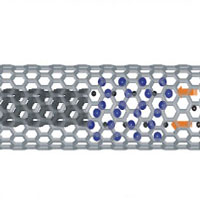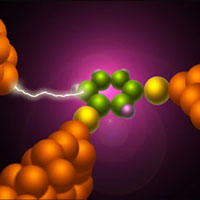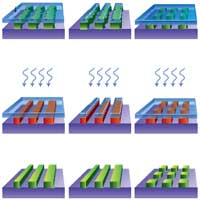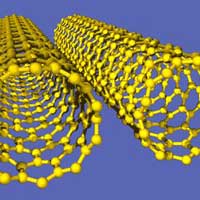Showing Spotlights 2233 - 2240 of 2785 in category All (newest first):
 As far as test tubes go, it doesn't get any smaller than a single-walled carbon nanotube (SWCNT). Among the wide range of interesting properties exhibited by SWCNTs is their capacity to encapsulate molecules within their quasi one-dimensional cavity. The confinement offered by the nanotube could serve as a nanoscale test tube to constrain a chemical reaction. This was demonstrated in principle back in 1998, when the coalescence of adjacent fullerenes was observed by transmission electron microscopy. In the following years, scientists have extensively experimented with filling nanotubes with other fullerenes, atoms, molecules and, very recently, with organic molecules. Owing to their large variety with diverse chemical properties, the incorporated organic molecules can tune the properties of the SWCNTs. Scientists are intrigued by the possibilities that SWCNTs' use as a reaction tube offers for chemistry at the nanoscale. Nanochemistry - a key to control self-assembly processes prerequisite for nanotechnology - in essence would produce stable chemical reactions inside a confined nanoscale space. Encapsulated inside this nanoscale space, molecules are isolated from the outside environment, which allows one to identify and control the source and incidence of chemical reactions. Recent work has demonstrated this new chemistry by using SWCNTs as a nanometer-scale reaction furnace.
As far as test tubes go, it doesn't get any smaller than a single-walled carbon nanotube (SWCNT). Among the wide range of interesting properties exhibited by SWCNTs is their capacity to encapsulate molecules within their quasi one-dimensional cavity. The confinement offered by the nanotube could serve as a nanoscale test tube to constrain a chemical reaction. This was demonstrated in principle back in 1998, when the coalescence of adjacent fullerenes was observed by transmission electron microscopy. In the following years, scientists have extensively experimented with filling nanotubes with other fullerenes, atoms, molecules and, very recently, with organic molecules. Owing to their large variety with diverse chemical properties, the incorporated organic molecules can tune the properties of the SWCNTs. Scientists are intrigued by the possibilities that SWCNTs' use as a reaction tube offers for chemistry at the nanoscale. Nanochemistry - a key to control self-assembly processes prerequisite for nanotechnology - in essence would produce stable chemical reactions inside a confined nanoscale space. Encapsulated inside this nanoscale space, molecules are isolated from the outside environment, which allows one to identify and control the source and incidence of chemical reactions. Recent work has demonstrated this new chemistry by using SWCNTs as a nanometer-scale reaction furnace.
May 9th, 2008
 Regulations and legal provisions can serve several purposes. From a regulator's perspective priority is given to aspects of human safety and environment protection. For commercial firms, regulations on the one hand imply restrictions (compliance) and on the other hand offer a frame of reference and predictability of legal decisions. From a civil society's point of view regulations can be trust-building in the sense that it indicates a certain level of safety. A lack of regulations calls for voluntary measures in order to make sure that this kind of basic trust can be established. The following article aims at shedding light on this field of tension and gives an overview of the current state of European nanotechnology regulation.
Regulations and legal provisions can serve several purposes. From a regulator's perspective priority is given to aspects of human safety and environment protection. For commercial firms, regulations on the one hand imply restrictions (compliance) and on the other hand offer a frame of reference and predictability of legal decisions. From a civil society's point of view regulations can be trust-building in the sense that it indicates a certain level of safety. A lack of regulations calls for voluntary measures in order to make sure that this kind of basic trust can be established. The following article aims at shedding light on this field of tension and gives an overview of the current state of European nanotechnology regulation.
May 8th, 2008
 The catalytic conversion of chemical to mechanical energy is ubiquitous in biology, powering such important and diverse processes as cell division, skeletal muscle movement, protein synthesis, and transport of cargo within cells. Catalytic 'engines' will be key components of active micron- and sub-micron scale systems for controlled movement, particle assembly, and separations. A few days ago we took a look at catalytic nanomotors - sophisticated molecular-size biomotors have evolved in nature - and described an example where researchers supercharged their nanomotors by inserting carbon nanotubes into the gold and platinum nanowires (Speeding up catalytic nanomotors with carbon nanotubes). Today we show an example where catalytic nanomotors can, in principle, be tethered or coupled to other objects to act as the engines of nanoscale assemblies. Additionally, an object that moves by generating a continuous surface force in a fluid can, in principle, be used to pump the fluid by the same catalytic mechanism. Thus, by immobilizing these nanomotors, a group of scientists have developed micro/nanofluidic pumps that transduce energy catalytically.
The catalytic conversion of chemical to mechanical energy is ubiquitous in biology, powering such important and diverse processes as cell division, skeletal muscle movement, protein synthesis, and transport of cargo within cells. Catalytic 'engines' will be key components of active micron- and sub-micron scale systems for controlled movement, particle assembly, and separations. A few days ago we took a look at catalytic nanomotors - sophisticated molecular-size biomotors have evolved in nature - and described an example where researchers supercharged their nanomotors by inserting carbon nanotubes into the gold and platinum nanowires (Speeding up catalytic nanomotors with carbon nanotubes). Today we show an example where catalytic nanomotors can, in principle, be tethered or coupled to other objects to act as the engines of nanoscale assemblies. Additionally, an object that moves by generating a continuous surface force in a fluid can, in principle, be used to pump the fluid by the same catalytic mechanism. Thus, by immobilizing these nanomotors, a group of scientists have developed micro/nanofluidic pumps that transduce energy catalytically.
May 7th, 2008
 Ask 10 people what nanotechnology is and you will get 10 different answers. And then there are all these terms floating around: 'bottom-up' and 'top-down' fabrication, 'atomically precise manufacturing', 'molecular assembly', 'self-assembly', 'nanorobots', 'nanofactories' and so forth. Try describing nanotechnology as a top-down fabrication process and the folks over at Foresight and CRN will tell you what a short-sighted wuss you are. Try describing nanotechnology the Drexlerian way as a bottom-up molecular assembly technology and some scientists will tell you that you are smoking too much of the good stuff. And then of course you hear about all these 'nanotechnology' products already hitting the market - but they seem decidedly low-tech, such as golf balls, 'no-smell' socks, toothpaste, scratch-resistant car paint, and so on - that's what we have been investing billions and billions of dollars for? Pretty confusing, huh? Let's start to disentangle...
Ask 10 people what nanotechnology is and you will get 10 different answers. And then there are all these terms floating around: 'bottom-up' and 'top-down' fabrication, 'atomically precise manufacturing', 'molecular assembly', 'self-assembly', 'nanorobots', 'nanofactories' and so forth. Try describing nanotechnology as a top-down fabrication process and the folks over at Foresight and CRN will tell you what a short-sighted wuss you are. Try describing nanotechnology the Drexlerian way as a bottom-up molecular assembly technology and some scientists will tell you that you are smoking too much of the good stuff. And then of course you hear about all these 'nanotechnology' products already hitting the market - but they seem decidedly low-tech, such as golf balls, 'no-smell' socks, toothpaste, scratch-resistant car paint, and so on - that's what we have been investing billions and billions of dollars for? Pretty confusing, huh? Let's start to disentangle...
May 6th, 2008
 The controversy over the use of nanoparticles in everyday products, such as cosmetics, has been going on for a while now. At best, the evidence is inconclusive - it's too early to say whether there is a risk or not. The cosmetics industry of course argues that their nanoparticle-containing products are perfectly safe because no problem has been reported so far. Consumer, health and environmental groups beg to differ and claim that there is a potential risk because we just don't know enough about this issue and that we rather should err on the side of caution. The fact is, as a recent report by the European Commission's Health and Consumer Protectorate states, that at present there is inadequate information on hazard identification, exposure assessment, uptake, the role of physico-chemical parameters of nanoparticles determining absorption and transport across membranes in the gut and lungs, the role of physico-chemical parameters of nanoparticles in systemic circulation determining biokinetics and accumulation in secondary target organs, possible health effects, and translocation of nanoparticles via the placenta to the foetus. The EU report concludes that conventional risk assessment methodologies may be adequate for products that contain soluble and/or biodegradable nanoparticles but not for insoluble and/or biopersistent nanoparticles.
The controversy over the use of nanoparticles in everyday products, such as cosmetics, has been going on for a while now. At best, the evidence is inconclusive - it's too early to say whether there is a risk or not. The cosmetics industry of course argues that their nanoparticle-containing products are perfectly safe because no problem has been reported so far. Consumer, health and environmental groups beg to differ and claim that there is a potential risk because we just don't know enough about this issue and that we rather should err on the side of caution. The fact is, as a recent report by the European Commission's Health and Consumer Protectorate states, that at present there is inadequate information on hazard identification, exposure assessment, uptake, the role of physico-chemical parameters of nanoparticles determining absorption and transport across membranes in the gut and lungs, the role of physico-chemical parameters of nanoparticles in systemic circulation determining biokinetics and accumulation in secondary target organs, possible health effects, and translocation of nanoparticles via the placenta to the foetus. The EU report concludes that conventional risk assessment methodologies may be adequate for products that contain soluble and/or biodegradable nanoparticles but not for insoluble and/or biopersistent nanoparticles.
May 5th, 2008
 In the past, random defects caused by particle contamination were the dominant reason for yield loss in the semiconductor industry - defects occur in the patterning process (so-called process defects) when contaminants become lodged in or on the wafer surface. Trying to prevent such fabrication defects, chip manufacturers have spent much effort and money to improve the fabrication process, for instance by installing ultra-clean fabrication facilities. With the semiconductor industry's move to advanced nanometer nodes, and feature sizes approaches the limitation of the fabrication method used, particles are no longer the only problem for chip manufacturers. In a nanoscale feature-size fabrication environment, systematic variations, such as metal width and thickness variations or mask misalignment, are also major contributors to yield loss. Rather than perfecting a nanostructure by improving its original fabrication method, researchers at Princeton University have demonstrated a new method, known as self-perfection by liquefaction (SPEL), which removes nanostructure fabrication defects and improves nanostructures after fabrication.
In the past, random defects caused by particle contamination were the dominant reason for yield loss in the semiconductor industry - defects occur in the patterning process (so-called process defects) when contaminants become lodged in or on the wafer surface. Trying to prevent such fabrication defects, chip manufacturers have spent much effort and money to improve the fabrication process, for instance by installing ultra-clean fabrication facilities. With the semiconductor industry's move to advanced nanometer nodes, and feature sizes approaches the limitation of the fabrication method used, particles are no longer the only problem for chip manufacturers. In a nanoscale feature-size fabrication environment, systematic variations, such as metal width and thickness variations or mask misalignment, are also major contributors to yield loss. Rather than perfecting a nanostructure by improving its original fabrication method, researchers at Princeton University have demonstrated a new method, known as self-perfection by liquefaction (SPEL), which removes nanostructure fabrication defects and improves nanostructures after fabrication.
May 4th, 2008
 Sophisticated molecular-size motors have evolved in nature, where they are used in virtually every important biological process. In contrast, the development of synthetic nanomotors that mimic the function of these amazing natural systems and could be used in man-made nanodevices is in its infancy. Building nanoscale motors is not just an exercise in scaling down the design of a macroworld engine to nanoscale dimensions. Many factors such as friction, heat dissipation and many other mechanical behaviors are just very different at this scale - everything is constantly moving (under kinetic energy supplied by the heat of the surroundings) and being buffeted by other atoms and molecules (Brownian motion). In nature, biological motors use catalytic reactions to create forces based on chemical changes. These motors do not require external energy sources such as electric or magnetic fields. Instead, the input energy is supplied locally and chemically. Despite impressive progress over the past years, man-made nanomachines lack the efficiency and speed of their biological counterparts. New research has demonstrated that the incorporation of carbon nanotubes (CNT) into the platinum component of asymmetric metal nanowire motors leads to dramatically accelerated movement in hydrogen peroxide solutions, with average speeds of 50-60 micrometers per second.
Sophisticated molecular-size motors have evolved in nature, where they are used in virtually every important biological process. In contrast, the development of synthetic nanomotors that mimic the function of these amazing natural systems and could be used in man-made nanodevices is in its infancy. Building nanoscale motors is not just an exercise in scaling down the design of a macroworld engine to nanoscale dimensions. Many factors such as friction, heat dissipation and many other mechanical behaviors are just very different at this scale - everything is constantly moving (under kinetic energy supplied by the heat of the surroundings) and being buffeted by other atoms and molecules (Brownian motion). In nature, biological motors use catalytic reactions to create forces based on chemical changes. These motors do not require external energy sources such as electric or magnetic fields. Instead, the input energy is supplied locally and chemically. Despite impressive progress over the past years, man-made nanomachines lack the efficiency and speed of their biological counterparts. New research has demonstrated that the incorporation of carbon nanotubes (CNT) into the platinum component of asymmetric metal nanowire motors leads to dramatically accelerated movement in hydrogen peroxide solutions, with average speeds of 50-60 micrometers per second.
May 1st, 2008
 It wasn't market forces that landed a man on the moon; and It wasn't market forces that led France to build a nuclear energy infrastructure that now enables it to generate some 75% of its entire energy needs from nuclear power (just an example of what energy policy can do; let's not get into a discussion here of nuclear energy, though). But somehow, the leading political and industrial forces in the United States - together with China the largest emitter of greenhouse gases on the planet - think that a task so fundamental and massive as fighting global warming and environmental pollution should mostly be left 'to the market'. Unfortunately, it's just a matter of economic reality that 'the market' will not invest in new energy technologies on a large scale until existing ways of producing energy become more expensive than producing alternative energies - which at the moment they aren't. As is the case with almost all emerging technologies, government initially lends a helping hand before the technology becomes a viable commercial proposition and the market takes over (remember how the Internet got created?). In the case of future clean energy technologies, it appears that this 'helping hand' needs to be massive and swift. It's not so much that clean/green tech wouldn't develop over time on its own. But it's against the backdrop of accelerating global warming that it becomes a top priority that requires massive public resources.
It wasn't market forces that landed a man on the moon; and It wasn't market forces that led France to build a nuclear energy infrastructure that now enables it to generate some 75% of its entire energy needs from nuclear power (just an example of what energy policy can do; let's not get into a discussion here of nuclear energy, though). But somehow, the leading political and industrial forces in the United States - together with China the largest emitter of greenhouse gases on the planet - think that a task so fundamental and massive as fighting global warming and environmental pollution should mostly be left 'to the market'. Unfortunately, it's just a matter of economic reality that 'the market' will not invest in new energy technologies on a large scale until existing ways of producing energy become more expensive than producing alternative energies - which at the moment they aren't. As is the case with almost all emerging technologies, government initially lends a helping hand before the technology becomes a viable commercial proposition and the market takes over (remember how the Internet got created?). In the case of future clean energy technologies, it appears that this 'helping hand' needs to be massive and swift. It's not so much that clean/green tech wouldn't develop over time on its own. But it's against the backdrop of accelerating global warming that it becomes a top priority that requires massive public resources.
Apr 30th, 2008
 As far as test tubes go, it doesn't get any smaller than a single-walled carbon nanotube (SWCNT). Among the wide range of interesting properties exhibited by SWCNTs is their capacity to encapsulate molecules within their quasi one-dimensional cavity. The confinement offered by the nanotube could serve as a nanoscale test tube to constrain a chemical reaction. This was demonstrated in principle back in 1998, when the coalescence of adjacent fullerenes was observed by transmission electron microscopy. In the following years, scientists have extensively experimented with filling nanotubes with other fullerenes, atoms, molecules and, very recently, with organic molecules. Owing to their large variety with diverse chemical properties, the incorporated organic molecules can tune the properties of the SWCNTs. Scientists are intrigued by the possibilities that SWCNTs' use as a reaction tube offers for chemistry at the nanoscale. Nanochemistry - a key to control self-assembly processes prerequisite for nanotechnology - in essence would produce stable chemical reactions inside a confined nanoscale space. Encapsulated inside this nanoscale space, molecules are isolated from the outside environment, which allows one to identify and control the source and incidence of chemical reactions. Recent work has demonstrated this new chemistry by using SWCNTs as a nanometer-scale reaction furnace.
As far as test tubes go, it doesn't get any smaller than a single-walled carbon nanotube (SWCNT). Among the wide range of interesting properties exhibited by SWCNTs is their capacity to encapsulate molecules within their quasi one-dimensional cavity. The confinement offered by the nanotube could serve as a nanoscale test tube to constrain a chemical reaction. This was demonstrated in principle back in 1998, when the coalescence of adjacent fullerenes was observed by transmission electron microscopy. In the following years, scientists have extensively experimented with filling nanotubes with other fullerenes, atoms, molecules and, very recently, with organic molecules. Owing to their large variety with diverse chemical properties, the incorporated organic molecules can tune the properties of the SWCNTs. Scientists are intrigued by the possibilities that SWCNTs' use as a reaction tube offers for chemistry at the nanoscale. Nanochemistry - a key to control self-assembly processes prerequisite for nanotechnology - in essence would produce stable chemical reactions inside a confined nanoscale space. Encapsulated inside this nanoscale space, molecules are isolated from the outside environment, which allows one to identify and control the source and incidence of chemical reactions. Recent work has demonstrated this new chemistry by using SWCNTs as a nanometer-scale reaction furnace.
 Subscribe to our Nanotechnology Spotlight feed
Subscribe to our Nanotechnology Spotlight feed





